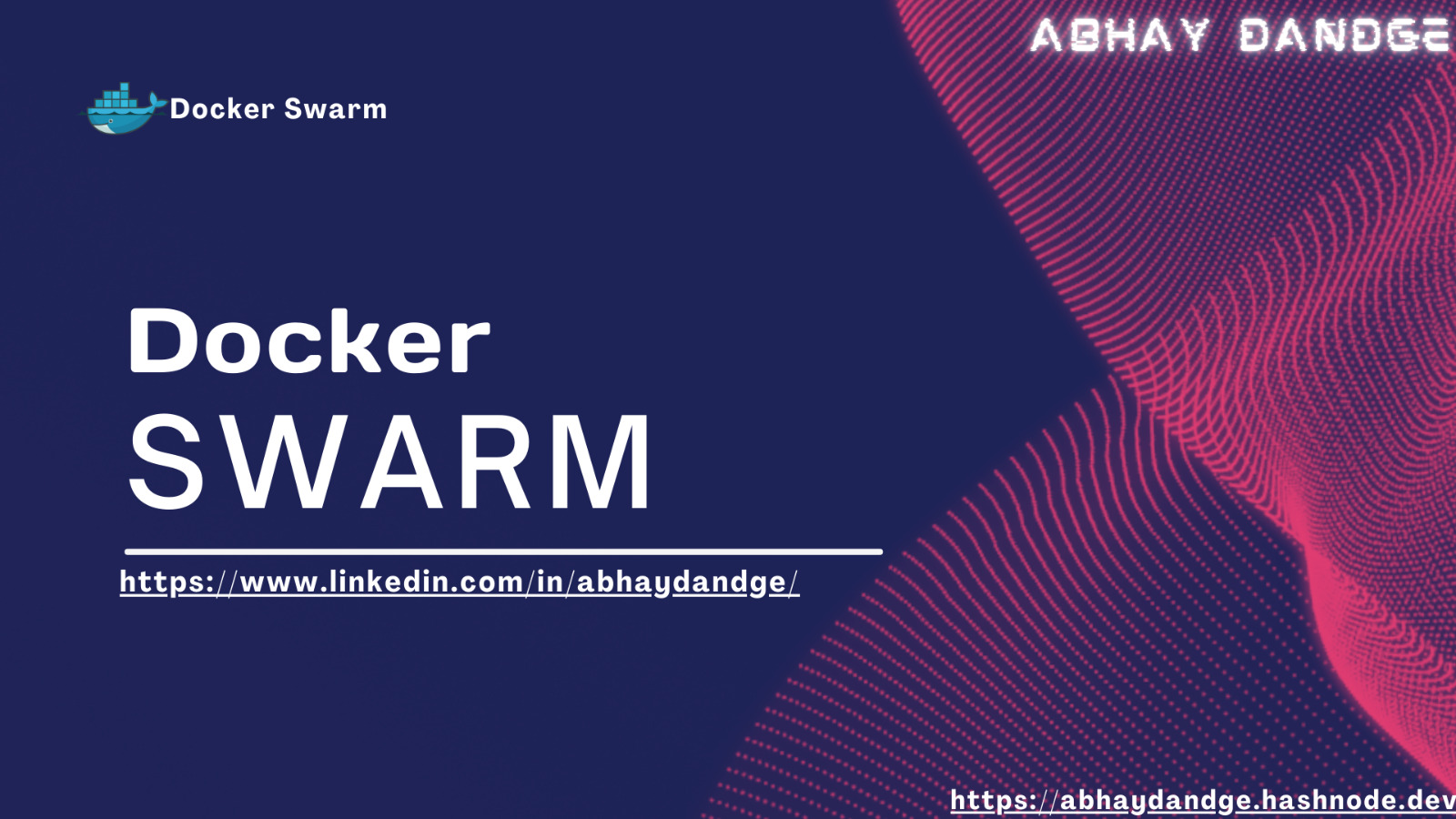Introduction to Docker Swarm: Simplifying Container Orchestration
 Abhay Dandge
Abhay Dandge
Introduction
🚀 Ready to master container management like a pro? 🌐
🐳 Ever feel like managing containers is like herding cats? Let's change that with Docker Swarm!
Managing a bunch of Docker containers can be a real headache. But what if I told you there's a tool that makes it easy and fun? Enter Docker Swarm – your new best friend for orchestrating containers. In this guide, we'll dive into the basics of Docker Swarm, its standout features, and how to get started.
What is Docker Swarm?
Docker Swarm is like the ringleader of a circus, but for containers. It transforms a group of Docker engines into a single, powerful virtual engine. This means you can deploy, scale, and manage services across multiple Docker hosts effortlessly.
Key Features of Docker Swarm
Clustering: Think of it as combining multiple computers into one supercomputer.
Service Discovery: Automatically finds the best spot for your apps to run.
Load Balancing: Ensures even distribution of work across your containers.
Declarative Service Model: You tell Docker Swarm what you want, and it makes it happen.
Scaling: Easily adjust the number of container replicas with a single command.
Security: Built-in TLS encryption ensures secure communication between nodes.
Getting Started with Docker Swarm
Step 1: Install Docker
Before jumping into Docker Swarm, you need Docker installed. If you haven’t done this yet, no worries – here’s how:
For Ubuntu:
sudo apt-get update
sudo apt-get install \
ca-certificates \
curl \
gnupg \
lsb-release
sudo mkdir -p /etc/apt/keyrings
curl -fsSL https://download.docker.com/linux/ubuntu/gpg | sudo gpg --dearmor -o /etc/apt/keyrings/docker.gpg
echo \
"deb [arch=$(dpkg --print-architecture) signed-by=/etc/apt/keyrings/docker.gpg] https://download.docker.com/linux/ubuntu \
$(lsb_release -cs) stable" | sudo tee /etc/apt/sources.list.d/docker.list > /dev/null
sudo apt-get update
sudo apt-get install docker-ce docker-ce-cli containerd.io docker-buildx-plugin docker-compose-plugin
For CentOS:
sudo yum install -y yum-utils
sudo yum-config-manager \
--add-repo \
https://download.docker.com/linux/centos/docker-ce.repo
sudo yum install docker-ce docker-ce-cli containerd.io docker-buildx-plugin docker-compose-plugin
sudo systemctl start docker
sudo systemctl enable docker
Step 2: Initialize Docker Swarm
With Docker installed, let’s turn on the magic. Initialize Docker Swarm on your manager node:
docker swarm init
This will output a command to join worker nodes to the Swarm.
Step 3: Join Worker Nodes to the Swarm
On each worker node, run the command provided by the docker swarm init command:
docker swarm join --token <token> <manager-ip>:2377
Step 4: Deploy a Service
Now for the fun part. To deploy an Nginx service with 3 replicas, use:
docker service create --name my-nginx --replicas 3 -p 80:80 nginx
Step 5: Managing Services
You can easily scale your service with:
docker service scale my-nginx=5
And to remove a service, use:
docker service rm my-nginx
Conclusion
Docker Swarm is your go-to tool for making container management a breeze. Whether you're a seasoned DevOps guru or a newbie, Docker Swarm simplifies clustering, service discovery, load balancing, and scaling. Give it a try and transform your container orchestration today!
For more in-depth guides and DevOps insights, check out my other blog posts here.
Stay connected and let's continue the DevOps journey together:
LinkedIn: Connect with me
Twitter (X): Follow me
GitHub: Check out my projects
Happy containerizing! 🚢✨
Subscribe to my newsletter
Read articles from Abhay Dandge directly inside your inbox. Subscribe to the newsletter, and don't miss out.
Written by

Abhay Dandge
Abhay Dandge
Hello, I'm Abhay, a DevOps Engineer passionate about optimizing operations through automation, continuous integration, and deployment. Over the past year, I've sharpened my skills in the fast-paced world of DevOps and Cloud Computing. My journey has been defined by hands-on experience and a commitment to exploring the latest technologies. ╭━━━╮╱╱╱╱╱╭━━━╮ ╰╮╭╮┃╱╱╱╱╱┃╭━╮┃ ╱┃┃┃┣━━┳╮╭┫┃╱┃┣━━┳━━╮ ╱┃┃┃┃┃━┫╰╯┃┃╱┃┃╭╮┃━━┫ ╭╯╰╯┃┃━╋╮╭┫╰━╯┃╰╯┣━━┃ ╰━━━┻━━╯╰╯╰━━━┫╭━┻━━╯ ╱╱╱╱╱╱╱╱╱╱╱╱╱╱┃┃ ╱╱╱╱╱╱╱╱╱╱╱╱╱╱╰╯⠀⠀⠀⠀⠀⠀⠀⠀⠀⠀⠀⠀⠀⠀⠀⠀⠀⠀⠀⠀⠀⠀⠀ In my tech toolkit, I’ve got the skills to make things run smoother: containerization, cloud platforms, and flawless CI/CD pipelines. My goal? To supercharge software delivery for organizations, making it faster and more efficient, all while keeping things top-notch and rock-solid. Let’s keep it cool and reliable! 🅃🄴🄲🄷 🅂🅃🄰🄲🄺 🔲 Cᴏɴᴛᴀɪɴᴇʀɪᴢᴀᴛɪᴏɴ -: Dᴏᴄᴋᴇʀ | Pᴏᴅᴍᴀɴ | Bᴜɪʟᴅᴀʜ | CᴏɴᴛᴀɪɴᴇʀD 🔲 Cᴏɴᴛᴀɪɴᴇʀ Oʀᴄʜᴇsᴛʀᴀᴛɪᴏɴ -: Kᴜʙᴇʀɴᴇᴛᴇs | Dᴏᴄᴋᴇʀ Sᴡᴀʀᴍ 🔲 Cʟᴏᴜᴅ Pʟᴀᴛғᴏʀᴍs -: AWS 🔲 Aᴜᴛᴏᴍᴀᴛɪᴏɴ ᴀɴᴅ Sᴄʀɪᴘᴛɪɴɢ-: Bᴀsʜ, Pʏᴛʜᴏɴ * Linux Administration (RHCSA) 🔴 * DevOps methodologies. * CLA (Certified Linux Admin) * CCA (Certified Container Admin) -̶-̶-̶-̶-̶-̶-̶-̶-̶-̶-̶-̶-̶-̶-̶-̶-̶-̶-̶-̶-̶-̶-̶-̶-̶-̶-̶-̶-̶-̶-̶-̶-̶-̶-̶-̶-̶-̶-̶-̶-̶-̶-̶-̶-̶-̶-̶-̶-̶-̶-̶-̶-̶-̶-̶-̶-̶-̶-̶-̶-̶-̶-̶-̶-̶-̶-̶-̶-̶-̶-̶-̶-̶-̶-̶-̶-̶-̶-̶-̶-̶-̶-̶-̶-̶-̶-̶-̶-̶-̶-̶-̶-̶-̶-̶-̶-̶-̶-̶-̶-̶-̶- How can I help you? I can help you with the optimization and scalability of your infrastructure with my expertise in Linux, Containers, AWS, and orchestration. From streamlining deployments with Docker and Kubernetes to maximizing cloud efficiency, I'll ensure your systems are robust and scalable. Let's tackle your challenges and take your projects to the next level. Let's connect and discuss how we can collaborate! :) -̶-̶-̶-̶-̶-̶-̶-̶-̶-̶-̶-̶-̶-̶-̶-̶-̶-̶-̶-̶-̶-̶-̶-̶-̶-̶-̶-̶-̶-̶-̶-̶-̶-̶-̶-̶-̶-̶-̶-̶-̶-̶-̶-̶-̶-̶-̶-̶-̶-̶-̶-̶-̶-̶-̶-̶-̶-̶-̶-̶-̶-̶-̶-̶-̶-̶-̶-̶-̶-̶-̶-̶-̶-̶-̶-̶-̶-̶-̶-̶-̶-̶-̶-̶-̶-̶-̶-̶-̶-̶-̶-̶-̶-̶-̶-̶-̶-̶-̶-̶-̶-̶-̶-̶-̶-̶-̶-̶-̶-̶-̶-̶-̶-̶- ………………………………………………………………… #devops #devsecops #sre